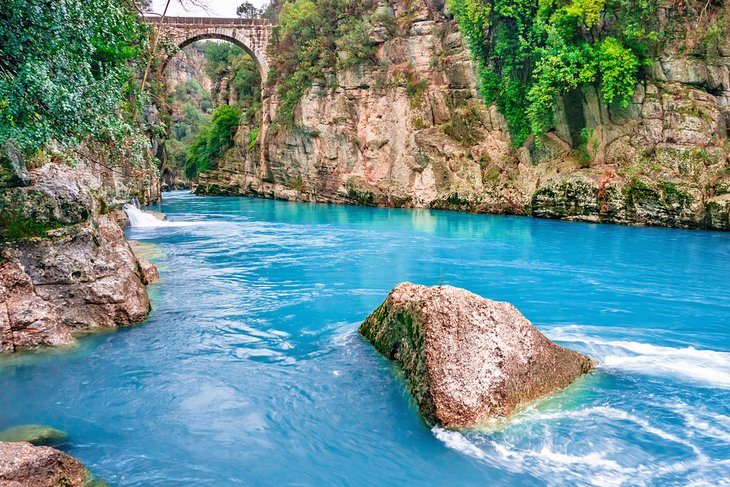Top Antalya travel attractions and vacation guides

Essential Antalya destinations and vacation tips and tricks: Oluk Bridge, Köprülü Canyon: Köprülü Canyon National Park is about 120 kilometers to the north of Alanya. It’s primarily known as one of the best places to visit in the region for rafting trips, which take place on the icy-blue river that winds through the canyon, but for more things to do, the area is also home to Roman ruins and plenty of hiking opportunities. Selge is the main Roman archaeological site in the area. The remnants of this once thriving city of 20,000 sit amid the lonely village of Altınkaya, 11 kilometers northwest of the canyon itself. The large Roman Theater, cut into the hillside and looming over the modern village houses, is well worth a visit here, despite the theater being partially destroyed. In the canyon itself, several tour companies run rafting trips along the Köprü River. The trips traverse the most scenic section of the river, heading under the Roman-built Oluk Bridge, which dates back to the 2nd century. The canyon is 14 kilometers long, with its walls soaring up to 400 meters high in places. Discover more info at side Turkey excursions.
In ancient times, the surrounding region known as Pamphylia had a cluster of cities, many of which are compelling archaeological sites today. So while you’re on the Turkish Riviera a visit to an archaeological museum will always be worthwhile. Alanya’s is famed for a bronze statue of Hercules, dating from the 2nd century CE and just over half a metre tall. Also on show are intact amphorae from the 2nd century BCE, coins going back as far as 700 BCE, an inscribed Phoenician tablet from 625 BCE and a 46-line letter by the Roman emperor Septimus Severus. The museum also has an ethnographic section detailing local ways of life down the years, as well as an outdoor space showing ancient agriculture techniques, and funeral customs from ancient times through the Islamic era.
Laodicea is located right across the ancient city of Hierapolis. It was once a trade city which was known with glossy black wool and eye salve trade. Mentioned in the Book of Revelation as the luke warm city. Recently Turkish archaeologists excavated a church dating to the time of Constantine. This is thought to be one of the earliest churches of the world. This site is recommended for biblical history lovers. Aphrodisias is 3 hours drive from Kusadasi town. Aphrodisias is derived from the goddess named as Aphrodite, the goddess of love. An artisan city known with sculpturors who made sculptures and sarcaphaguses with the local white marble. You can see the best examples of marble works in this city. The site has the most well preserved ancient stadium in the world which has a capacity of 30.000 people. The huge pool at the south agora is breathtaking.
Myra is an ancient city located in the Kale (Demre) district in Antalya. It is especially famous for the Lycian Period rock tombs, the Roman Period theater, and the Byzantine Period St. Nicholas (Santa Claus) Church. Saint Nicholas was a bishop in Myra, so the city maintained its reputation throughout the Middle Ages. Kekova is a small rocky island in Kaleköy and Üçağız near the Demre district in Antalya. It’s the largest island in the Turkish Mediterrenean. The Island of Kekova and the Sunken City, are some of the most visited places in the Mediterranean. They are unique historical places both underwater and on land.
Alanya Castle was built in 1221 by the Seljuk Sultan, Alaaddin Keykubat, who captured the city and had it rebuilt. You can take the cable car to go up to the castle. The cable car station is near Atatürk Park. You will need to walk uphill another 1 km to reach the entrance of the castle after exiting the cable car. İçkale (Inner castle) is the top sight up there. It’s an open air museum at the summit of the peninsula. Byzantine, Seljuk, and Ottoman artifacts can be found in the inner castle. When you go to Alanya Castle by cable car, you will come across the Süleymaniye Mosque, a Seljuk work renovated during the Ottoman period. There is also a covered bazaar (bedesten) behind the mosque.
Terrace Houses have gone down in history as a neighborhood located in the heart of Ephesus and appealing to the elite part of the city. Although there are no civilian residential areas in the center of ancient cities, Terrace Houses in Ephesus were an exception. The foundation of the Terrace Houses was laid in the 3rd century BC. After Ephesus became the capital of Asia, the neighborhood started to experience its brightest days (between the 1st and 3rd centuries AC). The most elite part of the city lived in the houses, so each residence was 400-950 square meters in size. The floors of the houses were decorated with mosaics and frescoes on the walls.
The six-kilometer stretch of ancient walls of Alanya Castle trail along the high promontory that shadows the modern sprawl of Alanya below. Inside the walls is Alanya’s old town district, the most interesting area of the city to explore. Alanya Castle’s history dates back to the Classical era, when this craggy, cave-riddled peninsula was a favorite haunt for pirates. The Greek-built fortifications were extended under Roman rule but it was during the Byzantine era that Alanya’s role as a Mediterranean seaport began to take off. Discover additional info on https://www.tourmoni.com/.
Starting at the western foot of that promontory is Alanya’s main beach, a long gentle arc of coarse sand bathed by low-to-moderate surf. Kleopatra Beach is wide, tapering only a little the further north you go, and gives you unbroken views of the castle and the brooding mass of the Taurus Mountains. There are beach clubs with sun loungers at intervals along the beach, and between the sand and Atatürk Boulevard is a wide promenade, blessed with those same panoramas, under swaying palms and buffered from the street by a strip of greenery with playgrounds and flowerbeds. On the east side of the beach is the lower station for a cable car that opened in summer 2017, whisking you up to the castle promontory. The Alanya Teleferik climbs 250 metres on a 900-metre line, and one of its 14 gondolas will depart every 19 seconds. On board you’ll be treated to astonishing 360° views, out over the Gulf of Antalya, across the resort and beyond to the Taurus Mountains.
